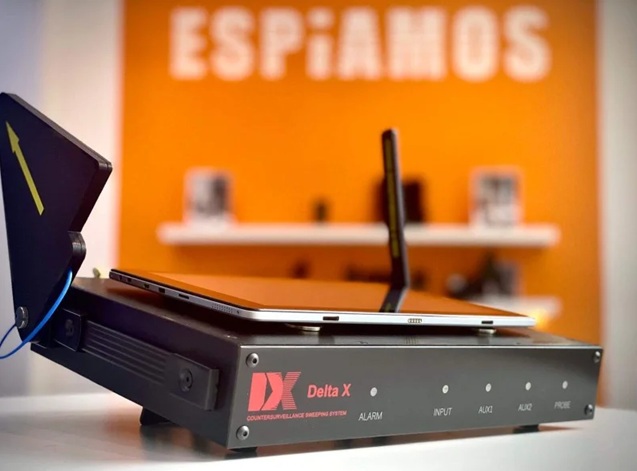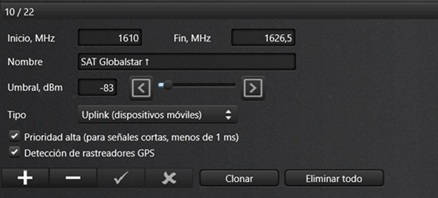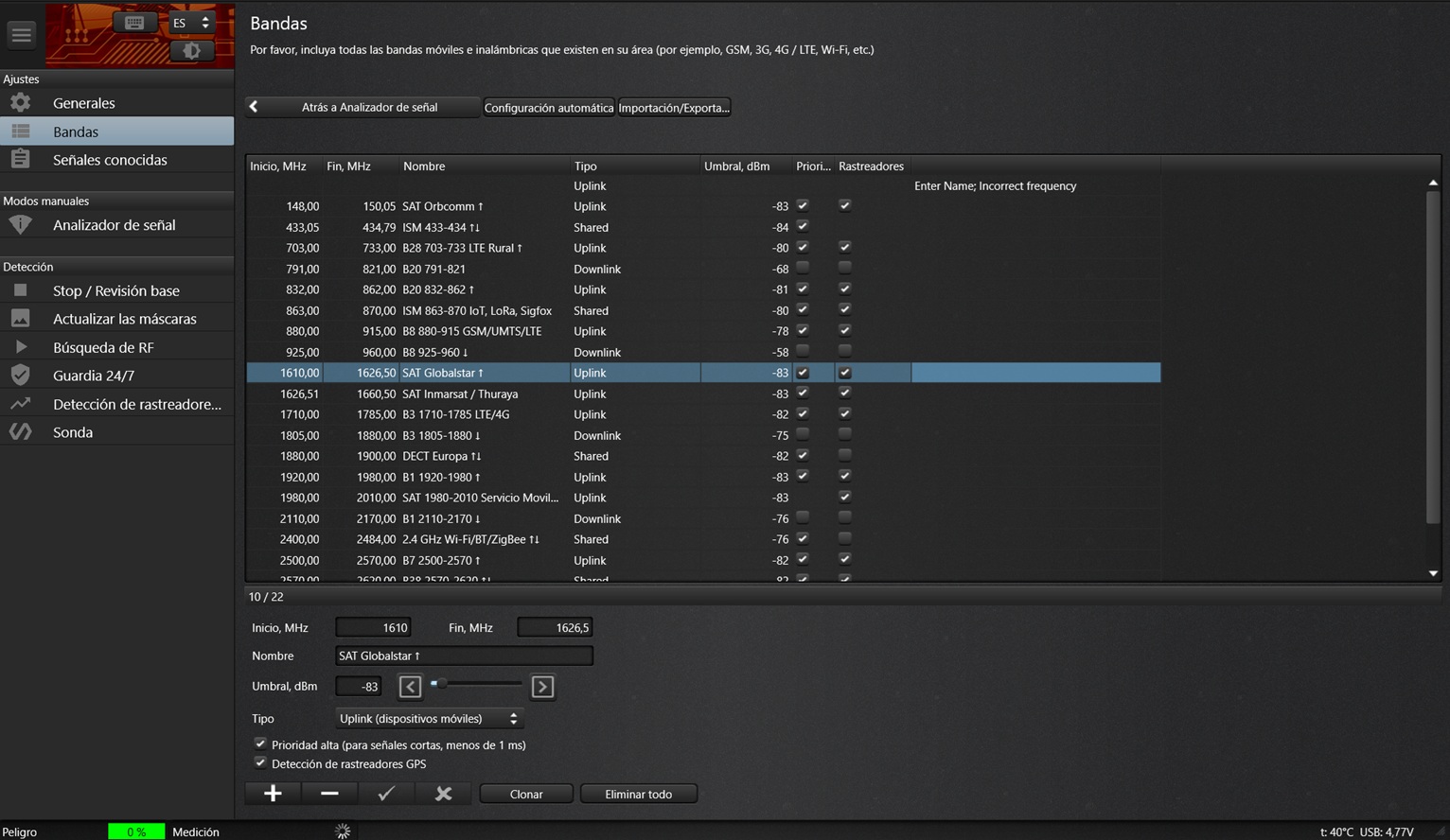Delta X allows you to manually add signals that are not included by default in the country settings . This feature is essential when working in complex environments or with specific technologies such as Globalstar, Inmarsat, Thuraya, LoRa networks, or ISM bands. To do this correctly, it's important to understand some technical concepts such as uplink and dBm values, which allow you to identify whether a signal is suspicious or expected.

Table of Contents
- What are the signals not included by default?
- Difference between uplink, downlink and shared
- What does dBm mean and how do I set it properly?
- Why do I have to add signals manually?
- How to add new frequencies to Delta X
- Conclusions on the management of non-standard signals
What are the signals not included by default?
When you first configure Delta X, the system automatically loads a database of legally used signals in the selected region. However, this database doesn't always include all possible frequencies, especially if you're working with satellite, industrial, or special systems not regulated in all countries.
Some of these "out-of-catalog" signals include services like Globalstar , Inmarsat , and Thuraya , or IoT technologies like LoRa and ISM frequencies (such as the 868 MHz or 433 MHz bands). If not added manually, these transmissions could cause operator confusion or even go unnoticed if the system doesn't flag them as relevant.
Difference between uplink, downlink and shared
What is uplink?
An uplink represents the transmission of data from a device to a ground tower, base station, or satellite. In TSCM tasks, detecting an uplink is especially relevant because it indicates that a device is transmitting . This can indicate the presence of a GSM microphone , a satellite GPS beacon , or any other spy device sending information to the outside world.
For example, a GPS beacon can activate its transmission module every 5 minutes and broadcast a data packet to a satellite (such as Globalstar) without the need for a SIM card. This short-duration transmission is a clear case of uplink. Another example would be a powered microphone that, upon detecting sound, activates transmission over the cellular network to send the audio in real time.
What is a downlink?
The downlink is the signal the device receives from outside . This can be remote activation commands, synchronization signals, or continuous data transmission from infrastructure such as mobile antennas or digital transmitters.
For example, a mobile phone constantly receives data from the network via downlink, such as network updates or control messages. Similarly, a GPS receiver passively listens for satellite signals to calculate its position, which is also considered downlinking, although it does not involve active transmission from the device.
In practice, detecting only downlinks does not necessarily imply a threat, but it does help contextualize legitimate signals in the environment and rule out false alarms.
What is shared?
The term "shared" refers to shared frequencies, i.e., bands that can be used for both uplink and downlink , depending on the technology or context of use. These mixed frequencies are common in IoT systems, LoRa networks, ISM bands, and even certain two-way satellite services.
For example, the 868 MHz ISM band can be used for an environmental sensor to send data (uplink) and receive instructions (downlink), all within the same band. Another example would be a wireless video surveillance system that uses a shared frequency to transmit video and receive control commands from the operator.
Detecting activity in shared bands requires special attention, as the same peak can represent an outgoing or incoming emission. Therefore, Delta X allows these signals to be labeled and analyzed based on their temporal behavior, power, and relative interference.
What does dBm mean and how do I set it properly?
The dBm is a unit that measures the power of a radio frequency signal relative to 1 milliwatt. Unlike absolute watts or milliwatts, the dBm is expressed on a logarithmic scale, making it easier to represent very high or very low power levels in spectral analysis.
In the context of Delta X, correctly interpreting the dBm level is critical to differentiating relevant signals from ambient noise . For example, an eavesdropping transmission might be detected at -45 dBm in a quiet environment, while the normal background spectrum is typically below -80 dBm.
Delta X allows you to set visual and operational thresholds based on the power level. If a signal exceeds the configured threshold, the system will flag it as a suspicious event or highlight it in the spectrum.
Setting the power threshold
From the advanced settings menu, the operator can adjust the minimum dBm threshold above which signals should be recorded or highlighted. This adjustment can be made by band or globally. For example:
- -70 dBm: for noisy urban environments, where only strong signals are desired to be detected.
- -85 dBm: For audits in quiet or protected areas, where it is important to capture even the weakest emissions.
It's also possible to set up automatic alerts when a signal exceeds a certain dBm value for a set period of time. This feature is useful for recording intermittent transmissions that might otherwise go unnoticed visually.
Contextual interpretation of dBm
The absolute dBm value doesn't always indicate whether a signal is dangerous or not. What matters is the relative behavior : if a signal appears above the threshold and isn't part of the known signals in the environment, it warrants investigation. On the other hand, a powerful but constant broadcast, such as an FM radio station, can be ignored if it is registered in the database.
Using dBm, Delta X provides an objective and standardized measurement that allows results to be compared between audits, detailed technical reports to be generated, and decisions to be justified to third parties.
Why do I have to add signals manually?
Although Delta X maintains a database of authorized signals, its effectiveness depends on how up-to-date and adapted this information is to the actual operating environment. In certain geographic areas or operational scenarios, technologies may be encountered that are not included by default in the system, such as private LoRa networks, industrial ISM links, regional satellite stations, or military communications systems.
If these signals are not added manually, the operator could interpret them as a threat when they are actually part of the local infrastructure, or conversely, overlook a transmission that does pose a risk simply because it is undocumented. Adding these signals allows for fine-tuning detection and reducing false positives , improving response capacity and increasing the reliability of generated reports.
How to add new frequencies to Delta X
Access to the configuration menu
From the main screen, the operator must access the configuration menu and select the "Bands" option. There, the list of all frequencies previously stored or recorded by the system is displayed.
Manual registration of the new signal
When you click “Add new signal,” a window opens where you can enter basic data, such as:
- Exact frequency range (e.g. 1610 - 1626.5 MHz for Globalstar uplink)
- Description or name (example: “Globalstar”)
- Estimated dBm intensity (example: -15 dBm)
- Signal type: uplink, downlink, shared

If it's a frequency that can be used by GPS trackers , it's essential to enable the "GPS Tracker Detection" option and mark it as "High Priority." This setting will automatically highlight the signal when using the GPS beacon-specific analysis mode, making it easier to detect in real time.
For example, the 1616 MHz frequency , which is used by the Globalstar satellite uplink, is not included in the database by default. If it is not manually added and marked as relevant to trackers, the Delta X will not identify it as a threat during a sweep. By entering it as a known signal, and also activating GPS mode and high priority, the system will generate a visual alert when that frequency is detected.
Once this form is completed, the signal will be registered in the active database. It will not be flagged as suspicious again during future analyses unless its behavior changes abnormally or a new scan profile is activated.
Recommended frequencies to record manually
Below is a table with examples of frequencies that are recommended to be manually entered into Delta X, especially in technical audits that include satellite, industrial or IoT technologies such as SigFox :
| Technology | Frequency (MHz) | Link Type | Estimated Power (dBm) | Used in GPS trackers? |
|---|---|---|---|---|
| Globalstar | 1610 – 1626.5 | Uplink | -85 | Yeah |
| Inmarsat / Thuraya | 1626.5 – 1660.5 | Uplink | -80 | Yeah |
| ISM 433 MHz | 433.05 – 434.79 | Shared | -70 | No |
| ISM 868 MHz (LoRa, SigFox, etc.) | 863 – 870 | Shared | -80 | Yeah |
These frequencies allow the Delta X to operate more accurately in environments where non-standard signals can cause confusion. When entered correctly, the system can identify, classify, and, if necessary, alert you about their appearance based on their behavior.

Identify the mobile operator of a 4G GPS tracker
One of the Delta X 's most advanced features is its ability to not only detect the presence of a 4G GPS tracker, but also determine which mobile operator the SIM card it's using belongs to . This is achieved by analyzing the exact uplink range where the transmission is occurring. Each operator has specific frequency blocks that the Delta X can easily identify during a spectral sweep.
| Technology | Band (MHz) | Operator | Uplink Range (MHz) | Bandwidth (MHz) |
|---|---|---|---|---|
| 3G | 2100 | Movistar | 1920 – 1935 | 15 |
| 3G | 2100 | Vodafone | 1935 – 1950 | 15 |
| 3G | 2100 | Orange | 1950 – 1965 | 15 |
| 4G | 800 | Movistar | 832 – 842 | 10 |
| 4G | 800 | Vodafone | 842 – 852 | 10 |
| 4G | 800 | Orange | 852 – 862 | 10 |
| 4G | 1800 | Movistar | 1710 – 1730 | 20 |
| 4G | 1800 | Vodafone | 1730 – 1750 | 20 |
| 4G | 1800 | Orange | 1750 – 1770 | 20 |
| 5G | 700 | Movistar | 703 – 713 | 10 |
| 5G | 700 | Vodafone | 713 – 723 | 10 |
| 5G | 700 | Orange | 723 – 733 | 10 |
For example, if during an analysis the Delta X detects a signal in the range 832–842 MHz, it's possible to pair it with a Movistar SIM card. The same applies if the transmission appears between 842–852 MHz (Vodafone) or 852–862 MHz (Orange). This level of accuracy is only achieved if each operator's uplink ranges have been manually added to the system as known signals.
Recording these ranges individually is essential. If a broad block is configured, such as 832–862 MHz , the Delta X will detect the signal, but it won't be able to visually identify which operator it belongs to . However, with specific and correctly labeled ranges, the system will immediately show whether the transmission is coming from a Movistar, Vodafone, or Orange SIM, which is key to reducing uncertainty in the analysis.
This functionality makes the Delta X a strategic analysis tool, capable of detecting spy devices while contextualizing the source of the communication . In a technical audit, an expert investigation, or a judicial proceeding, having a detailed record that includes the exact frequency, time of transmission, its duration, and the operator involved can make the difference between a mere suspicion and solid, verifiable technical evidence .
Conclusions on the management of non-standard signals
An advanced feature that improves analysis accuracy
The ability to add signals not included by default is one of the most powerful aspects of Delta X. Far from being a limitation, this feature allows the system to be adapted to any operating environment, from dense urban areas to critical installations with special technologies.
Understanding the difference between uplink and downlink, correctly interpreting dBm levels, and knowing how to record new signals is what makes an operator a skilled TSCM technician. With these features, the Delta X doesn't just detect threats— it learns and adapts to each environment with surgical precision .
If you'd like to delve deeper into these features, ESPIAMOS® offers specialized training in using Delta X , as well as TSCM courses tailored to different levels , including specific programs for detecting trackers in vehicles . Our team of instructors will guide you step by step to help you get the most out of this professional tool.






 WhatsApp
WhatsApp Telegram
Telegram


